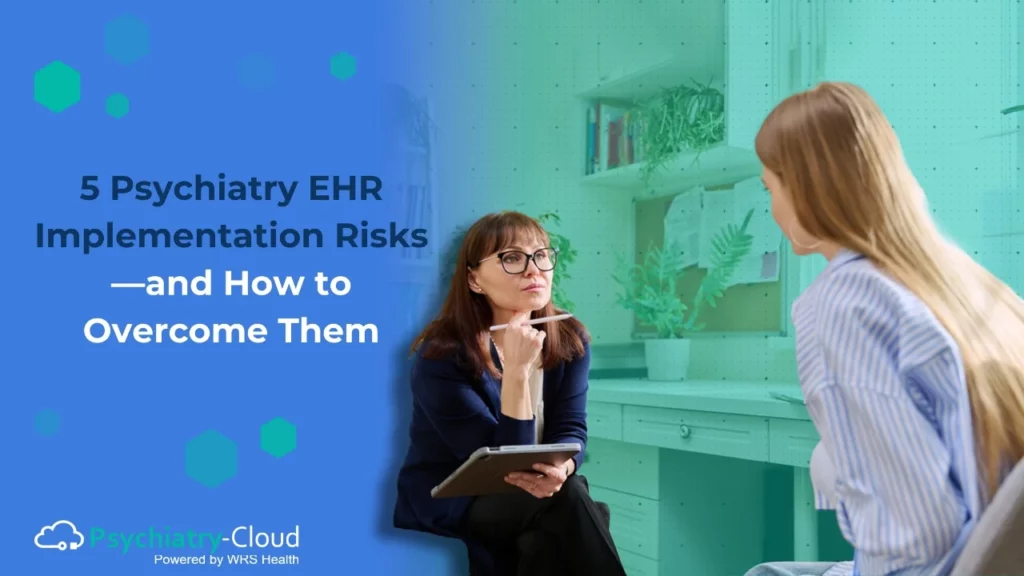Key Takeaways
- Address training, customization, and compliance early to ensure successful psychiatry EHR implementation.
- Choose a psychiatry EHR tailored to behavioral health practice management for better workflows and patient care.
- Test data migration and integrations thoroughly to avoid disruptions and ensure patient information security.
- Switching EHRs? Use our guide to navigate a smooth transition.
But here’s the good news. With the right strategies in place, you can sidestep common pitfalls and set your practice up for success. Whether you’re upgrading your system or starting fresh, addressing these five common risks head-on will help ensure a smoother transition and better outcomes for your team and your patients.
Table of Contents
Risk 1: Poor EHR User Training and Adoption
The solution:
- Tailor training programs to specific roles—clinicians, admins, and support staff each have unique needs.
- Use real-life scenarios, like creating treatment plans or completing behavioral health assessments, to make learning relevant and practical.
- Host regular refresher courses and provide an easily accessible library of training materials. Find a psychiatry EHR vendor that offers ongoing support and resources.
- Designate “super-users” on your team who can assist with questions and act as on-the-ground support.
Risk 2: EHR Data Migration Challenges
The solution:
- Audit your current records to identify errors or inconsistencies before migration begins.
- Collaborate with your psychiatry EHR vendor to establish a clear plan for transferring data.
- Test the new system with mock workflows to ensure critical information—like therapy notes and medication schedules—migrates correctly.
- Keep your old system accessible as a backup until you’re confident in the new one.
Risk 3: Lack of Customization for Psychiatry-Specific Needs
The solution:
- Choose an EHR designed specifically for mental healthcare. Look for features like customizable templates, medication management tools, and integrated psychological assessments.
- Ensure note templates are truly customizable, enabling you to add in and alter information fields to your needs.
- Work with your vendor to tweak templates and workflows to match your practice’s needs.
- Get your team involved in the selection process—after all, they’ll be the ones using the EHR every day.
PSYCHIATRY-CLOUD CLIENT
“…All of the providers just think it’s very simple to learn, easy to use, and you can navigate it quickly. And then having the billing taken off of our hands is very important.”
Jennifer Erdman, NP
Rapid City Mental Health Professionals
Risk 4: Compliance and Security Issues
The solution:
- Opt for an EHR with built-in safeguards like encryption, multi-factor authentication, and strict user access controls.
- Conduct regular internal audits to catch and fix compliance gaps, or look into a reputable third-party compliance service for behavioral health.
- Train your staff on privacy best practices, especially for areas like telehealth or mobile access.
- Have a plan in place for security incidents, including steps for notifying patients and regulators.

Risk 5: Integration Issues With Behavioral Health Practice Management Tools
The solution:
- Evaluate psychiatry EHR options for compatibility with your existing tools, like billing platforms and telehealth services.
- Run a trial period to test integrations and uncover potential issues. Psychiatry-Cloud offers extended trial options with all new service signups.
- Work with vendors to fine-tune integrations for your workflows, such as automating claims submissions or tracking patient no-shows.
- Keep all systems updated to ensure ongoing compatibility.
A Smoother Path to a Successful EHR Transition
Implementing a behavioral health EHR is no small feat, but with thoughtful planning and the right approach, it can transform your behavioral health practice management. Focus on training, customization, compliance, and integration, and you’ll not only reduce disruptions—you’ll also set the stage for a system that supports better care, happier staff, and healthier patients.










